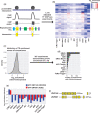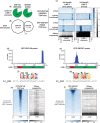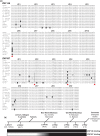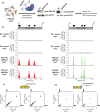ZNF146/OZF and ZNF507 target LINE-1 sequences
- PMID: 35100360
- PMCID: PMC8896011
- DOI: 10.1093/g3journal/jkac002
ZNF146/OZF and ZNF507 target LINE-1 sequences
Abstract
Repetitive sequences including transposable elements and transposon-derived fragments account for nearly half of the human genome. While transposition-competent transposable elements must be repressed to maintain genomic stability, mutated and fragmented transposable elements comprising the bulk of repetitive sequences can also contribute to regulation of host gene expression and broader genome organization. Here, we analyzed published ChIP-seq data sets to identify proteins broadly enriched on transposable elements in the human genome. We show 2 of the proteins identified, C2H2 zinc finger-containing proteins ZNF146 (also known as OZF) and ZNF507, are targeted to distinct sites within LINE-1 ORF2 at thousands of locations in the genome. ZNF146 binding sites are found at old and young LINE-1 elements. In contrast, ZNF507 preferentially binds at young LINE-1 sequences correlated to sequence changes in LINE-1 elements at ZNF507's binding site. To gain further insight into ZNF146 and ZNF507 function, we disrupt their expression in HEK293 cells using CRISPR/Cas9 and perform RNA sequencing, finding modest gene expression changes in cells where ZNF507 has been disrupted. We further identify a physical interaction between ZNF507 and PRMT5, suggesting ZNF507 may target arginine methylation activity to LINE-1 sequences.
Keywords: L1; LINE-1; OZF; PRMT5; ZNF146; ZNF507; transposable element.
© The Author(s) 2022. Published by Oxford University Press on behalf of Genetics Society of America.
Figures







Similar articles
-
OZF is a Claspin-interacting protein essential to maintain the replication fork progression rate under replication stress.FASEB J. 2020 May;34(5):6907-6919. doi: 10.1096/fj.201901926R. Epub 2020 Apr 8. FASEB J. 2020. PMID: 32267586
-
A Kruppel zinc finger of ZNF 146 interacts with the SUMO-1 conjugating enzyme UBC9 and is sumoylated in vivo.Mol Cell Biochem. 2005 Mar;271(1-2):215-23. doi: 10.1007/s11010-005-6417-2. Mol Cell Biochem. 2005. PMID: 15881673
-
Genomic organization and promoter identification of ZNF146, a gene encoding a protein consisting solely of zinc finger domains.Cytogenet Cell Genet. 2001;92(1-2):80-4. doi: 10.1159/000056873. Cytogenet Cell Genet. 2001. PMID: 11306801
-
Interspersed repeats and other mementos of transposable elements in mammalian genomes.Curr Opin Genet Dev. 1999 Dec;9(6):657-63. doi: 10.1016/s0959-437x(99)00031-3. Curr Opin Genet Dev. 1999. PMID: 10607616 Review.
-
LINE-1 retrotransposons: modulators of quantity and quality of mammalian gene expression?Bioessays. 2005 Aug;27(8):775-84. doi: 10.1002/bies.20257. Bioessays. 2005. PMID: 16015595 Review.
Cited by
-
Identification of mammalian transcription factors that bind to inaccessible chromatin.Nucleic Acids Res. 2023 Sep 8;51(16):8480-8495. doi: 10.1093/nar/gkad614. Nucleic Acids Res. 2023. PMID: 37486787 Free PMC article.
-
TMEM147 is a novel biomarker for diagnosis and prognosis of hepatocellular carcinoma.Genet Mol Biol. 2023 Jun 16;46(2):e20220323. doi: 10.1590/1678-4685-GMB-2022-0323. eCollection 2023. Genet Mol Biol. 2023. PMID: 37335919 Free PMC article.
References
-
- Antoine K, Ferbus D, Kolahgar G, Prosperi MT, Goubin G.. Zinc finger protein overexpressed in colon carcinoma interacts with the telomeric protein hRap1. J Cell Biochem. 2005a;95(4):763–768. - PubMed
-
- Antoine K, Prosperi MT, Ferbus D, Boule C, Goubin G.. A Kruppel zinc finger of ZNF 146 interacts with the SUMO-1 conjugating enzyme UBC9 and is sumoylated in vivo. Mol Cell Biochem. 2005b;271(1–2):215–223. - PubMed
-
- Bailey TL, Elkan C.. Fitting a mixture model by expectation maximization to discover motifs in biopolymers. Proc Int Conf Intell Syst Mol Biol. 1994;2:28–36. - PubMed
Publication types
MeSH terms
Substances
Grants and funding
LinkOut - more resources
Full Text Sources
Molecular Biology Databases
Miscellaneous
